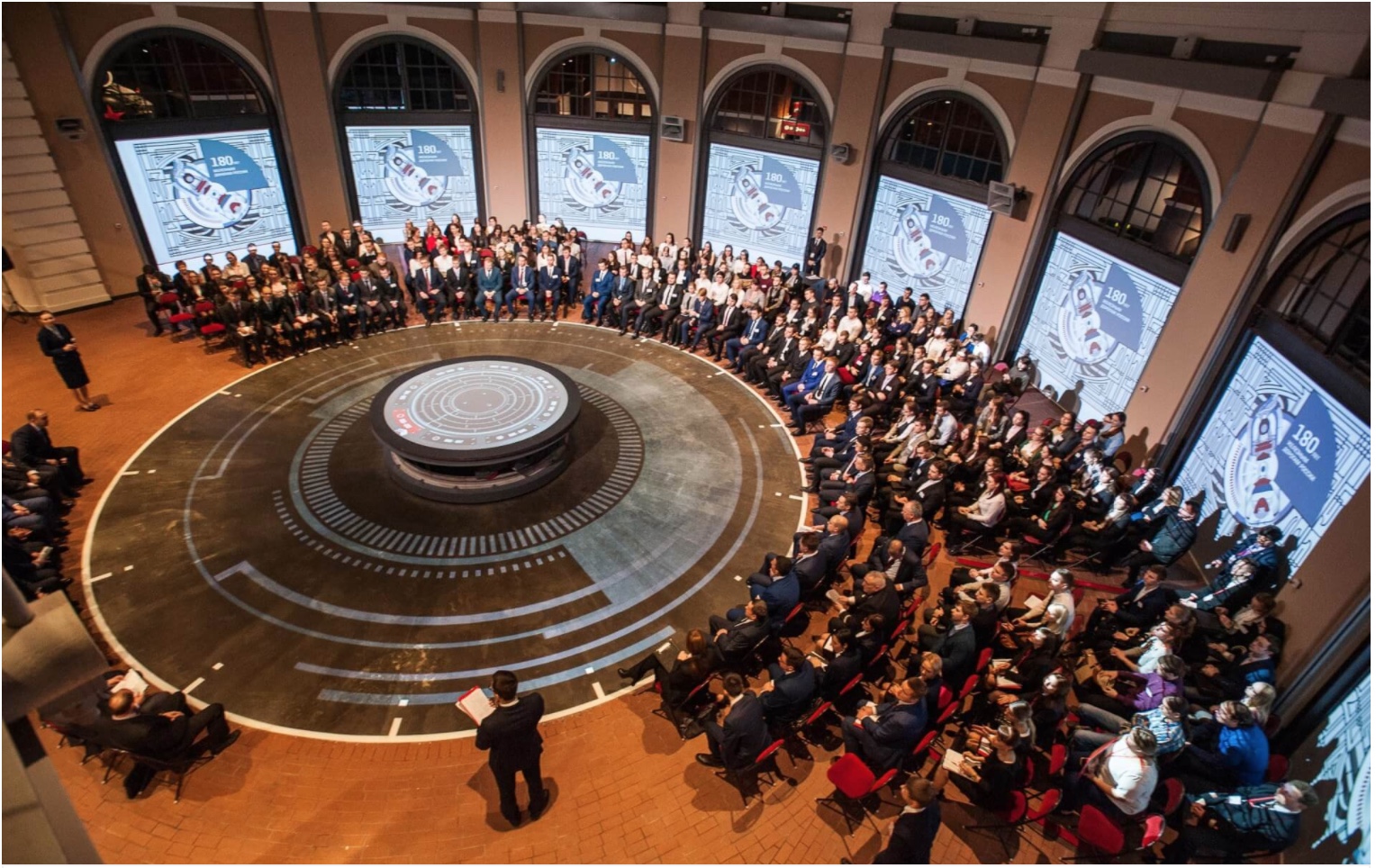Funktion-One features at the reborn Russian Railway Museum
Six Funktion-One sound systems – supplied by distributor for Russia, Edelweiss Audio – have been installed at the cutting-edge Russian Railway Museum in St Petersburg.
Established at the building of the former locomotive depot of the Peterhof railway, next to the functioning Baltiysky Station, it is one of the largest museums of its kind in the world. The huge indoor and outdoor site houses around 35,000 historical artefacts – including 118 pieces of rare steam trains, locomotives, electric locomotives, railcars and other rolling stock. As a fundamental method for traversing its expansive landscape and boasting an intriguing past to boot, the country has a proud history of railroad innovations.
This pride was evident in the ambitious concepts for the re-invented museum, which opened its first phase in October 2017. AV technology and moving elements would feature throughout, bringing a dynamic edge to the exhibits.
In order to achieve this, Vladimir Belyakov was appointed as Project Manager by main contractor Pitch Bureau for the exhibition elements of the museum, bringing with him extensive technical experience through his work with Digisky, AV Stumpfl and Kramer.
A spokesperson for the museum explained: “Technologies give visitors a better perception of the museum exposition, more detailed information about a particular exhibit and the ability to choose how they interact – viewing text, listening or watching a video.”
Hands of Time
One of the standout attractions, Hands of Time, recently won Best Audiovisual Installation at the international awards, Museums in Short 2020. Located in the Central Hall of the old depot building, it features eight archways filled with large double-sided projection screens (creating a 180-degree panoramic), a central projection mapped table that rotates on locomotive wheels and a 5.1 Funktion-One sound system.
Belyakov explains: “If you rotate this table, the mapping rotates too as a single surface. When the table stops it chooses one of eight historic periods. Then you go to the video show on eight screens of panoramic projection.”
The custom rotating table sends command via an encoder to the server room, where the Unreal Engine-based app is installed. This app sends the encoded data to the Screenberry software to blend the projection into one coherent image.
An abundance of hard surfaces combined with the size of the space (around 15m across) means there is a long reverberation time. This was overcome with the deployment of Funktion-One loudspeakers, which are renowned for their directivity and clarity. Multichannel mastering specifically for such a complex installation was done by the production studio Mediatact, which made a lot of sound design for this museum.
In addition to their sonic capabilities, Funktion-One’s skeletal speakers – two Evo 6SH and three Resolution 2SH – with their minimal horn look, worked with the visual aesthetic of the railway station. The addition of a BR221 bass reflex speaker completes the 5.1 semi-surround configuration. Power for the system comes from Funktion-One E30Q, E45 and E24 amps, with control handled by an X04 audio management system.
Edelweiss Audio’s Andrei Kremenchugskiy comments: “The space is quite big, so it was logical to use horn-loaded systems. As with any surround sound system we wanted to achieve some level of immersive sound. You can feel the sound around you and the intelligibility is good for what is a boomy room.”
Locomotive and Polonso Virtual Cuts
The Locomotive – Virtual Cut shows an ‘x-ray’ of the TEP70 main line single unit diesel passenger vehicle through different layers and infographics on six 55in LCD displays. Belyakov, who is also a sound artist, mixed the sound of the locomotive with futuristic effects to draw attention to the key technological talking points – tracking the video content from left to right.
The Polonso – Virtual Cut is similar but uses live footage mixed with graphics. In order to film the video content, Belyakov and his team had to move the camera with the same speed as the virtual cut engine.
Both installations feature six Funktion-One F55 speakers – which offer wide and even dispersion and excellent clarity for such a compact unit- powered by an E15 amplifier.
The museum spokesperson said: “High-quality sound is an integral part of the museum’s exposition, and creates a positive impression on visitors from the multimedia component of the project. It is impossible to simulate the beginning of the movement of a steam locomotive and the passage of a locomotive at a railway crossing on a low-quality sound.”
Railway Map
This installation consists of a large Absen LED screen with a 2mm pixel pitch showing the USSR’s railway network’s growth since 1917. The six-metre wide LED display is installed from edge to edge on the wall of the technical booth.
Belyakov explains: “We wanted to create a visually minimal, full-range sound system, which can achieve high SPL in the near field.”
To achieve this, two Funktion-One F55s and an MB210 mini bass unit were specified, along with an XO4 audio management system.
Railway Safety
Replicating a level crossing, the Railway Safety exhibition features a barrier, switchman’s booth, traffic light and, of course, the wind effect of the passing train together with moving sound complete with Doppler effect. This immersive audio content was recorded and mastered by Mediatact – regarded by Belyakov as the best sound design studio in Russia.
The clarity of the Funktion-One sound system – comprising three Resolution 2SHs, two BR115 bass reflex speakers, an F60Q amplifier and XO4 controller – ensures the playback is as realistic and convincing as possible.
Time Forward
Time Forward uses projection mapping to show visuals of a steam locomotive in the style of avant-garde, cubism and futurism – inspired by artists such as Malevich, Mayakovsky and others. The audio content is based around recited poetry, which needs to be clearly audible from the speaker positions high up in the ceiling. This challenge was answered with two Resolution 2SH skeletal speaker horns – offering the required throw and directivity – and an F118 bass speaker, powered by an F60Q amplifier and controlled by an XO2 audio management system.
Commenting on the sound system, the museum spokesperson said: “We are inpressed with the acoustic properties and excellent sound qualities of the Funktion-One speakers combined with the simple user interface and high reliability of failure. There have been no problems since opening in 2017.”


